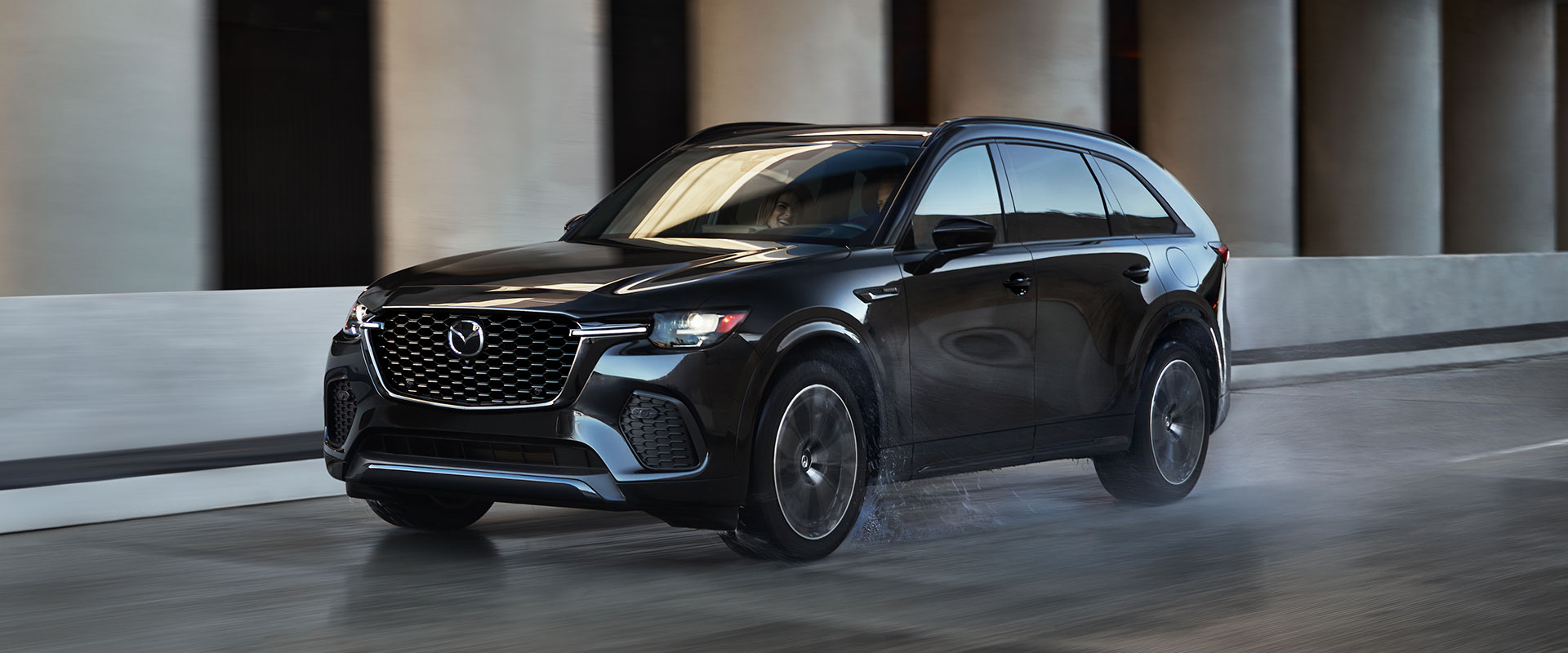2025 Mazda CX-70
A couple years ago, Mazda multiplied the CX-5 to make the then-new CX-50, followed in 2023 by the CX-90. Now in 2024, they’re finding an in-betweener of sorts with this 2025 Mazda CX-70.
I say “of sorts” because it’s really the same size as the current CX-90; that is, about 201 inches long on a 123-inch wheelbase. Powertrains, which we’ll touch on soon, are also identical.
The key difference is the CX-70’s omission of third-row seating, though there are a few other changes that give the 70 a chance to stand out. Are they enough? We were invited to Palm Springs, California, to decide that for ourselves.
As stated, the CX-70 and -90 are virtually the same looking at the overall external dimensions, standing with the same width and ground clearance as well. Even the first row experience is largely the same, like the 12.3-inch digital gauge cluster, standard on all CX-70 trims but the base Turbo model. It’s joined by an equally-sized and all-trims-standard infotainment screen tethered to Mazda’s command dial system in the center console. If you’re familiar with modern Mazdas, especially the 90, you’ll feel right at home.
First- and second-row legroom between the two is the same, the latter measured by Mazda at 39.4 inches. Behind those rearmost seats is the cavernous cargo space, measured at 39.6 cubic-feet with that second-row up, and up to 75.3 cubes with those seats folded down.
Still, these numbers are effectively the same as the CX-90 if you were to permanently fold down the third row, but measurements only tell so much of the story.
What the 70 gains is a new sub-trunk feature. Lift up the flat cargo floor to expose a series of spots and cubbies for various accessories, equipment, valuables or really whatever you’ve got. This space remains viable no matter which powertrain you opt for, even the plug-in hybrid.
And that’s actually where our driving adventure started. The PHEV is a 2.5-liter inline-four paired up with an eight-speed automatic, an electric motor and a 17.8 kWh battery pack. Total system output is 323 horsepower and 369 lb-ft of torque on Premium 93 fuel; the battery is rated at 25 miles of EV range. All-wheel drive is standard across all trims and powertrains, and tethered to Mazda’s typical focus on handling, the 70 offers a great on-road experience.
“There’s something about the way… Mazda makes their crossovers. It makes their utilities. I always say it’s because they take their sports car DNA and it’s trickled into their crossovers. And I think that’s very much the case when you look at the 50, when you look at the 90, and now when you look at the 70. I’m not saying competitors don’t do that, but Mazda just does it so well.
If you love to drive cars and you’re in the market for a utility, you should really be checking out the Mazda lineup.”
As for the plug-in hybrid system itself, look, it doesn’t knock socks off with immediate, gut-punching torque, but it does offer a smooth, quiet and more fuel conscious ride, and it’s a great option for those looking to ease into electric propulsion.
But with the sunrise came a new day and another CX-70, this time powered by the turbocharged 3.3-liter inline-six. This is the same engine used in the “Turbo” and “Turbo S” models, paired up to the same eight-speed automatic in the PHEV; again, all-wheel drive is standard.
The Turbo starts off with 280 horsepower and 332 lb-ft of torque. The Turbo S kicks things up to 340 HP and 369 lb-ft with Premium 93 fuel. This inline-six was one of our favorite things about the 90 and it’s the same story here.
“Alright, now, these are the kind of roads used to test a vehicle’s driving dynamics. This is day two and I’m behind the wheel of a Turbo model. And I have to say right off the bat, between this and the PHEV, I think I’d go with this.
Now, that’s not a slight or a dig against the plug-in. I think that one offers a very robust plug-in experience for the would-be buyer, but this inline six is just a little punchier. It’s got a little bit more muscle behind it. And to me that plays very well into Mazda’s sportier handling characteristics.
Mazda’s crossovers, they tend to lean a little bit more into the firmer ride and firmer suspension, the more taut steering everything like that. And to that extent the CX-70 plays into it very well. And again, that inline six I think plays into it very well.”
We’re glad to see these powertrains return for another midsize outing. And yes, while on the upper edges of the segment, the CX-70 is considered a midsize utility– a plenty spacious one at that.
With everything so similar, you may be wondering what the pricing looks like. Fortunately, that has stayed within the ballpark of the 90, starting at $41,900 for an entry-level Turbo Preferred, and that’s with destination; $53,905 will net you the first Turbo S, that’s the Premium trim, and $55,855 for the entry PHEV, another Premium grade. Technically speaking, the CX-70’s starting price is a couple grand more than the CX-90’s, and that’s because of differing trim structures and more standard equipment in the 70; however, trims shared between the two also share the same sticker price.
You know we’ll be putting the CX-70 through the Road Test paces soon. Until then and as always, drive safe and stay tuned to MotorWeek.






